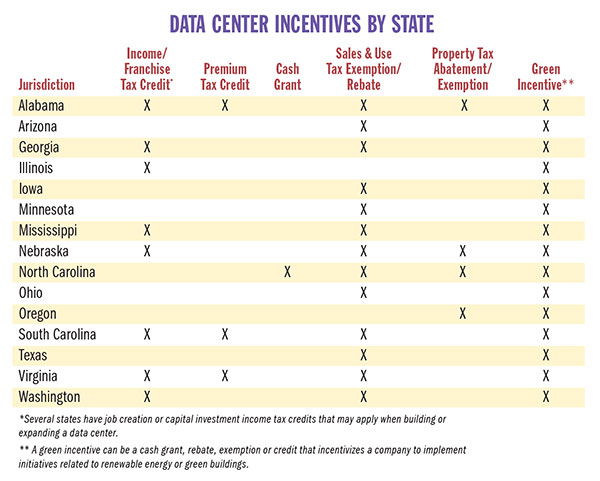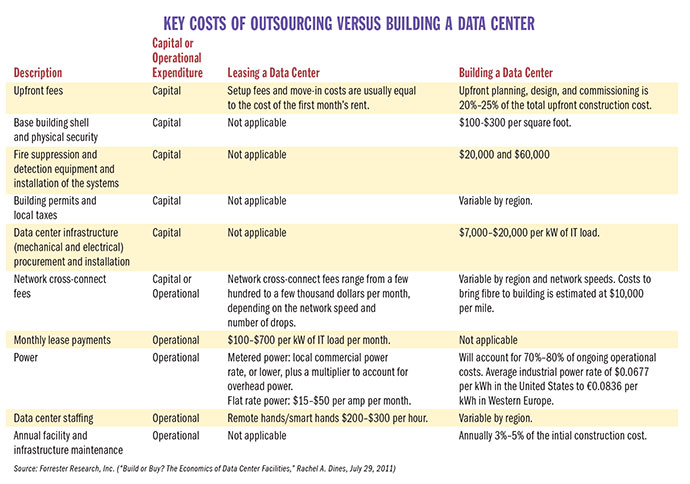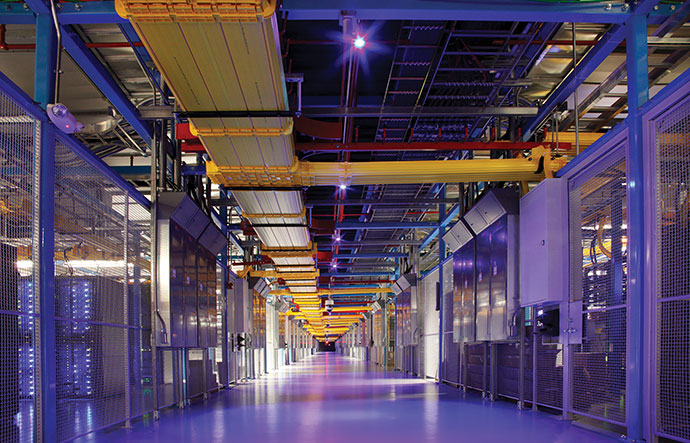Location selection – be it for a corporate headquarters, a manufacturing facility, a lab or a shared services center, is an important decision that must weigh numerous factors, meet business requirements and satisfy the long-term objectives of the company. Selecting a data center location is no different and may actually be more complex than traditional site location in that the decision by a company to build its own data center vs. leveraging that of a third-party provider, or perhaps the Cloud, must also be considered.
While data center site selection must be tailored to the company’s strategies and requirements, there are several locational considerations that are universally fundamental to choosing an appropriate site: environmental conditions, power sources and reliability, wide area network (WAN) capabilities, socioeconomic statuses, labor pools, real estate/land availability, costs, infrastructure and proximity to resources.
When examining a location’s WAN capabilities, Intel Corporation suggests that
there are three components that should be considered: capacity, reliability and redundancy.
One of the most critical aspects of selecting an optimal site is ensuring a detailed understanding of the business initiatives driving the location need and decision. These factors must be defined, documented and communicated so that the location criteria (e.g., cost, access, labor quality [if required], availability) are given proper weight in the decision-making process and the success of the project can be measured.
Step by Step
For data centers, it is essential to recognize the environmental factors associated with the locations under consideration. First and foremost, a region’s climate is strongly linked to the effectiveness of the data center cooling process. By avoiding warm climate locations, a firm will drive down sustaining costs, thereby maximizing efficiency and realizing economies of scale. Second, a region’s historical propensity toward natural disasters should be considered. While it may seem obvious to steer clear from regions that experience the catastrophic effects from floods, hurricanes, tornados and earthquakes, it is just as important to consider more minor environmental conditions, such as ice, high winds, or bad air quality. By minimizing facility exposure to harmful environmental elements, the firm will mitigate any systemic risk and potentially realize cost savings stemming from lower insurance costs.
A site’s power source – specifically the accessibility of the surrounding electrical power infrastructure – is an important consideration. Preferably, the data center should be powered by two mature utility providers, as this structure supports long-term competitive pricing of power, as well as a readily available alternative for the firm should one provider’s service begin to falter. Moreover, this structure enables redundancy and reduces risk, as the distribution of power is more reliable. Irrespective of the provider network, locating a data center proximate to the source of power generation helps support lower electrical costs, because power is easier to access from the grid.
The effectiveness of a data center is measured by its ability to communicate. Therefore, the network to a potential site is an important aspect of the selection process, because the availability and price of fiber infrastructure and communications will impact a data center’s performance. When examining a location’s WAN capabilities, Intel Corporation suggests that there are three components that should be considered: capacity, reliability and redundancy.
A capacity analysis measures how much fiber is already in place and ready for use, and assessing the current and future needs of the data center. Similar to the ideal competitive structure for a data center’s power source, having multiple WAN service providers that use separate points of entry is also preferred. Last, the firm should assess the diversity level of the communications paths being used by the providers, thereby gauging the reliability of the network in the midst
 of a localized outage. Ultimately, these three aspects should be evaluated with the sole goal of minimizing costs and network latency between the data center and its respective business units.
of a localized outage. Ultimately, these three aspects should be evaluated with the sole goal of minimizing costs and network latency between the data center and its respective business units.
It is also important to consider a location’s resource availability from a labor perspective, as the operational maintenance of a data center requires specific technical skills. By choosing locations that are proximate to an IT industry hub and/or near a university known for its IT program, the firm will increase its chances of recruiting top talent. The cost of IT resources, as well as historical and projected wage inflation, should also be considered.
Locations should be analyzed on their construction and land acquisition environment as well as their proximity to resources. Fundamentally, it is important to select a parcel of land that is large enough to accommodate the current and future activities of the data center, while still being within proximity to modern infrastructure and available resources. The ideal location will strike a balance between the two requirements.
The trend towards the greening of data centers prompts a greater focus on choosing sites that are closer to bodies of water, as the proximity to hydroelectric power allows data centers to operate on alternative, renewable resources.
State-Specific Data Center Incentives
Another important criterion not to be overlooked is incentives that exist specifically for data centers. Approximately 15 states have enacted specific data center incentives to entice companies to build or expand in their state (see matrix chart).
Data center incentives have traditionally been available to the owner of the data center, the party that actually builds a data center from the ground up and makes a large initial investment in both real and personal property. As co-location becomes a more popular option for companies, some states have recently gone through the process of amending their programs to allow not only the data center owners to be eligible for the incentives, but also the tenants that are co-locating in the space.
Typically, the construction of a data center requires a large investment in real and personal property and few to no permanent jobs. However, there are at times job creation requirements to be able to qualify for such incentives programs. Such criteria should be carefully considered. Not meeting such commitments could result in clawbacks/penalties.
Expanding or constructing a data center may be the right time to incorporate green initiatives. A “greener” data center not only has a positive environmental impact, but may offer financial returns as well. A large number of utility companies offer rebates to data centers using best practices and working to improve upon energy efficiencies.
In addition to utility rebates, many companies have introduced the use of fuel cells as a building-level power source. Fuel cells convert energy from a fuel (usually hydrogen) into electricity. The result is a reliable energy source with low emissions. While advances in technology are lowering costs, fuel cells remain expensive. However, several states, as well as the federal government, offer credits or incentives.
Outsource or Build
When considering data center needs of a company, there may be some thought given to outsourcing the data center by way of co-location or using “the Cloud” versus building a new facility. Co-location outsources the peripheral data center infrastructure (cooling, power distribution and backup, building space, network bandwidth, site security, etc.). The Cloud is a complete outsource of all physical and virtual IT resources.
On its face, it seems that outsourcing would be much cheaper and less maintenance, and in some cases, that may be true. However, upon taking a closer look at costs, risk, and incentives that may be available to build a data center, it may not be such an obvious answer. A detailed analysis of these components along with federal and state tax impacts must be conducted to reach a final decision.
The risk of non-compliance that may come with outsourcing may be greater than the cost of building a data center.
No doubt, building and maintaining an in-house data center requires significant up-front costs including, but not limited to, high capital costs, full-time staff dedicated to IT, backup generators, cooling infrastructure, staff to support the equipment, etc. Having an “owned” data center does have its upside though: complete control over operating environment and all IT resources, convenient/conducive location, low risk of losing the lease, and the ability to leverage and share existing space.
Co-location trades some or all of the benefits of in-house infrastructure, but it offers its own benefits. First, there are no capital costs for facilities. There is a shorter time to market – with an agreement in place with a co-location provider, a business can be up and running in a few days versus the months it would take to build a data center. The company would still retain ownership (and control) of IT equipment, and have the opportunity to leverage provider experience to reduce errors during IT deployment. Additionally, the company would also have stronger security due to economies of scale the provider can obtain. Last, co-location allows for increased mobility – if your business is moving or relocating, there is the flexibility to do so without having to consider data center relocation.
The downsides to co-locating include sharing facilities, which may lead to risks when it comes to data security. Costs can vary from month to month depending on usage of resources (like network bandwidth). Location of the facility could be anywhere, so deployment of resources to fix IT equipment can prove to be costly. Great effort should be expended to ensure that a good service level agreement (SLA) is negotiated and in place to avoid service issues and interruption. When it comes time to change service providers for whatever reason, it may not be easy to move IT equipment from one provider to another.
The Cloud retains some of the characteristics of co-locating when it comes to pros and cons, except that with the Cloud, all of the IT resources in addition to the facility are under the provider’s control, including the IT equipment (unlike co-locating). Pros in this model include not having to bear any direct capital cost. Also, cost amortization across customers helps keep costs low. If more or less scalability is required at some point, it can simply be ordered; there are no equipment consideration to be undertaken. Because there have been no major investments made in equipment or resources, switching or using multiple providers is an easy option to consider.
In terms of cons, there is lack of control of the infrastructure and resources when using the Cloud. Also, since the Cloud is relatively new, there are still questions as to who owns the data once it is uploaded. In that respect, security becomes a concern. As mentioned above, outsourcing may seem like an inexpensive option, but network costs can quickly add up and outweigh any perceived initial savings. Last, because it is the “Cloud,” the provider is essentially ethereal, and therefore not able to provide “hands on service.”
When considering whether to build or outsource, a major risk needs to be considered that could outweigh all financial costs: the risk of non-compliance. Being compliant should be thought of from a service and regulatory perspective. If outsourcing, consider whether the SLA with the provider matches the SLA that is in place with customers. If the company’s SLA states 99 percent availability and the provider can only provide 95 percent availability, then the company will be running a risk of not complying with the agreement that it has with its customers.
There are providers that say they are operating at 95 percent availability, but in reality they are between 50 percent and 60 percent availability, again putting the company at risk at high volume times. Being able to measure the provider’s service levels is, as a key performance indicator, a good first step in mitigating service interruptions or failures.
Security and regulatory compliance are imperative. A breach in security may cause a business or trade secrets to be compromised and can be detrimental in itself. Moreover, similar to a security breach, a regulatory breach can cost reputation, customers, careers and in some cases, the business as a whole. When outsourcing, it is important that the provider is able to meet all of the security and regulatory requirements for which the company must be compliant. For these two reasons, the overall cost of building a data center may pale in comparison to the risk of being non-compliant.

In looking at the decision from strictly a financial point of view, outsourcing seems to be an inexpensive option compared to building a facility. The key costs chart outlines the key costs of outsourcing versus building a data center. Five of the 10 major costs are not applicable for outsourcing a facility, thus indicating a huge overall savings to outsource. However, if incentives and credits are considered, at least five items can be partially or fully offset depending on where the data center is located – size, amount of capital expenditure (including operational expenditure), type of power, and if there are any employees associated with the build. Cost/benefit analyses often do not layer in credits and incentives and therefore skew the actual cost of the project at hand. These items are large considerations and should be a part of the cost evaluation.
Understanding the differences between building or outsourcing data center operations and being able to layer on top site selection considerations and available incentives is important when companies are making data center decisions. Evaluating each one of these items separately and then as a whole can considerably change the initial perception of a data center project. What may seem obvious at the outset with regard to cost, risk, security, etc., may be drastically different upon considering the full range of factors.
